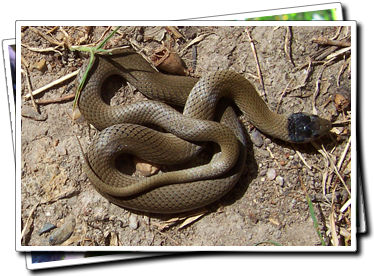Grey Snake
Species name: (Hemiaspis damelii)
Other Common names:None known.
Mildly Venomous
Grey Snake.
Significance to Humans:
Mildly venomousBites from this species are poorly recorded with the only significant occurrence involving the death of a dog. All bites should still be treated immediately and attended to with correct first aid.
General description:
Uniform olive to grey above, with scales tipped black anteriorly especially on the flanks (dorso-laterally). An indicative dark stripe is common place behind the head but may occasionally be faint or absent. Ventral surfaces are generally white to cream, with occasional dark grey flecking.
Average Length:
45-50cm with a maximum length around 60cm.
Habitat in SE Qld:
Favours woodlands especially eucalypt communities, usually on heavier, cracking clay soils prone to seasonal inundation. Particularly associated with water bodies or naturally occurring drainage features.
General habits:
Generally nocturnal to crepuscular but has been seen active foraging in ground crevices during the early morning.
Diet:
Frogs appear the main dietary component with skinks also included.
Local distribution:
Recorded throughout suitable habitat in the Lockyer and Esk Valleys extending west throughout the Darling Downs.
Around the home:
The habitat preference of this species would see it occur mainly within rural properties containing favoured localities. Only one known capture within a home on the Lockyer Valley.
Copyright © 2015 Brisbane Snake Catchers, All rights reserved.
Web site by Serenity Computer Services

.jpg)
.jpg)
.jpg)
.jpg)